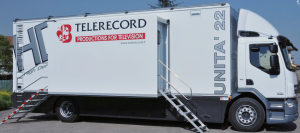Exploring Telerecord’s latest Unit 22 Full HD OB (part 1)
 Florence-based company Telerecord has in the last few years diversified its business in order to capitalise on its experience gained in the field. As well as being a broadcast supplier with a variety of OB units in its arsenal, the company is also active as a systems integrator that constructs and sells complete, ready-to-use OB units.
Florence-based company Telerecord has in the last few years diversified its business in order to capitalise on its experience gained in the field. As well as being a broadcast supplier with a variety of OB units in its arsenal, the company is also active as a systems integrator that constructs and sells complete, ready-to-use OB units.
The latest unit was developed together by several companies that have been collaborating for many years with Telerecord, including Restar (Sergio Resti collaborates with Bertini since 1972) and Aret of the Asti family, and GDL Engineering by Attilio Guadalupi.
The new Unit 22 constructed by Telerecord represents the state of the art in this range of TV mobile vehicles, contained within a 10 metre frame, and in fact constitutes Unit 22 number five. The previous four were sold to a variety of TV services and international broadcasters.
It should be stressed that the OB vehicles made by Telerecord are the result of the experience of those who use the same OB vans on a daily basis for their primary activity: broadcast shooting.
Telerecord also boasts a number of technological advances, acquired over many years of sustained work. In particular, an impressive double expansion has been created in the director’s area. The basic idea was to have spaces available that are comparable with those in vehicles of larger dimensions. Suffice to say that on this unit there are as many as 15 operational areas, comfortable in just 8.20 metres in length and 4.10 metres in width with the double expansion.
The impression one gets, upon entering the vehicle, is that one is in a 14 metre truck due to the sheer size of the functional space.
The main characteristic of this new OB vehicle is therefore represented by the double expansion, which allows the user to have a considerable space inside and a great flexibility. In the director’s area as many as 15 people can be accommodated in 8.32 metres.
In terms of cameras, Sony HDC 2500s were chosen, connected with fiber optic, for the highest quality even at long distances (with certain devices up to 10 km), a feature that was much appreciated in the previous TV production of a major skiing championship. The Ethernet trunk covers every requirement of transmitting several signals simultaneously. With other accessories it can carry four streams to achieve 4K, in addition to another stream towards the TV camera. Moving forward, the design of the vehicle is such that future upgrades could be accommodated.
The CCU Camera Control Unit, for example, is already compatible with 4K if an interface is added. For the Sony MVS 7000 mixer, only the software needs to be updated and the same is true for the Snell matrix, which now provides manual addressing and should soon receive a software release that allows it to manage input and output streams with 4K.
The mixer currently provides 60 inputs (expandable up to 80) of 24 outputs (expandable to 48). In fact, additional cards up to 20 inputs each are foreseen. For the audio part, the Yamaha mixer can be remotely operated with an Ethemet connection, even at long distances. The whole system is configured in Dolby 5.1.
The second part of this article will appear on SVG Europe tomorrow.
